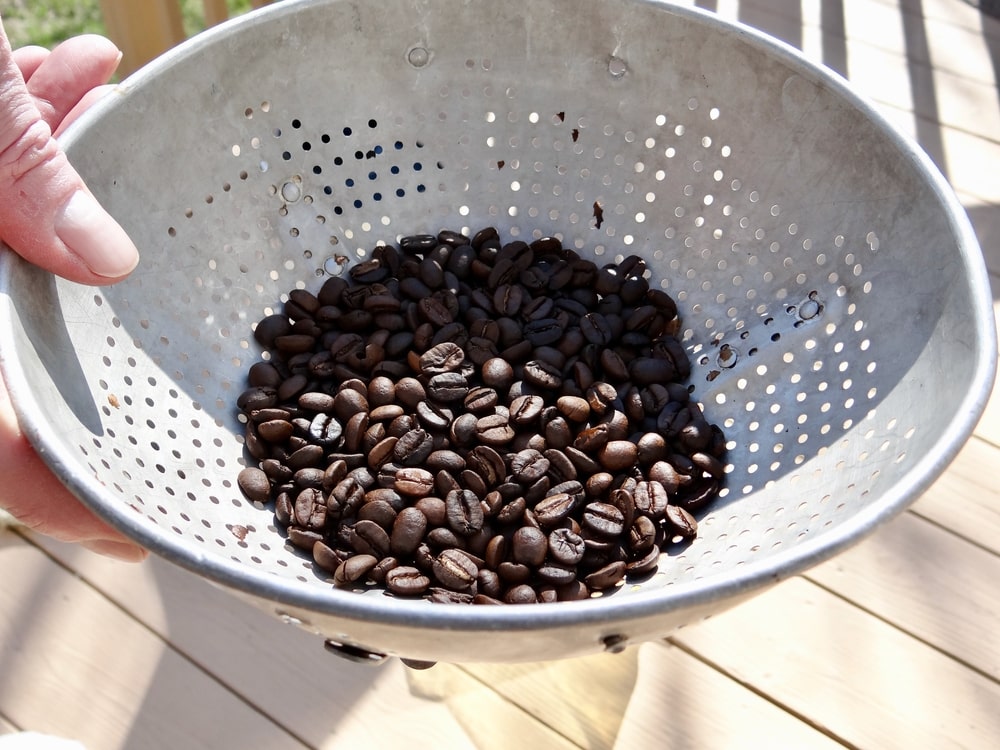
If you are a diehard coffee lover, you already know that freshly roasted beans are by far the most flavorful. And what could be more fresh than roasting coffee yourself? This process can sound daunting, but it is actually easier than you might think.
There are three simple ways for you to roast your own coffee beans at home: in a pan on the stove, in the oven, and a popcorn popper. We are going to introduce these methods to you, along with all the steps to roast beans using those methods.
Note: You can perform these methods with inexpensive gear found in your home. However, you can also buy a dedicated coffee roaster machine.

Home Coffee Roasting Essentials
Before you start your home roasting adventure, there’s some coffee knowledge you need. These five bits of information will help you understand what you’re about to do. Then we will get into the detailed how-to’s.
1. Ventilation
You need to be able to ventilate the room you are roasting in. Look for a fan on your oven to use, or have a window open. There will be some smoke during the roasting process, and preparing ventilation in advance makes it easy to deal with.
2. Roast Level
Notice the color changes and cracks in the beans during the roasting process. They will start out green, then change to yellow, to light brown, to golden brown, to dark brown. You’ll also see and hear the cracks the beans make. When they turn from light brown to golden brown, they crack the first time. This is when you take them off the heat if you want a light roast, or wait another minute if you want a medium roast.
If not, let them cook from golden brown to dark brown, when they will crack a second time. This is when it will be a medium-dark to dark roast. Be sure to take the beans off shortly after the second crack, because they will get a very smoky flavor that will taste like charcoal if left on for too long. Nobody wants burned beans!
The beans will continue to cook after you take them off or out of the heat source while they cool, so be sure to account for that when choosing when to remove them.
RELATED READ: What are the four different types of roasts, and which one is right for you?
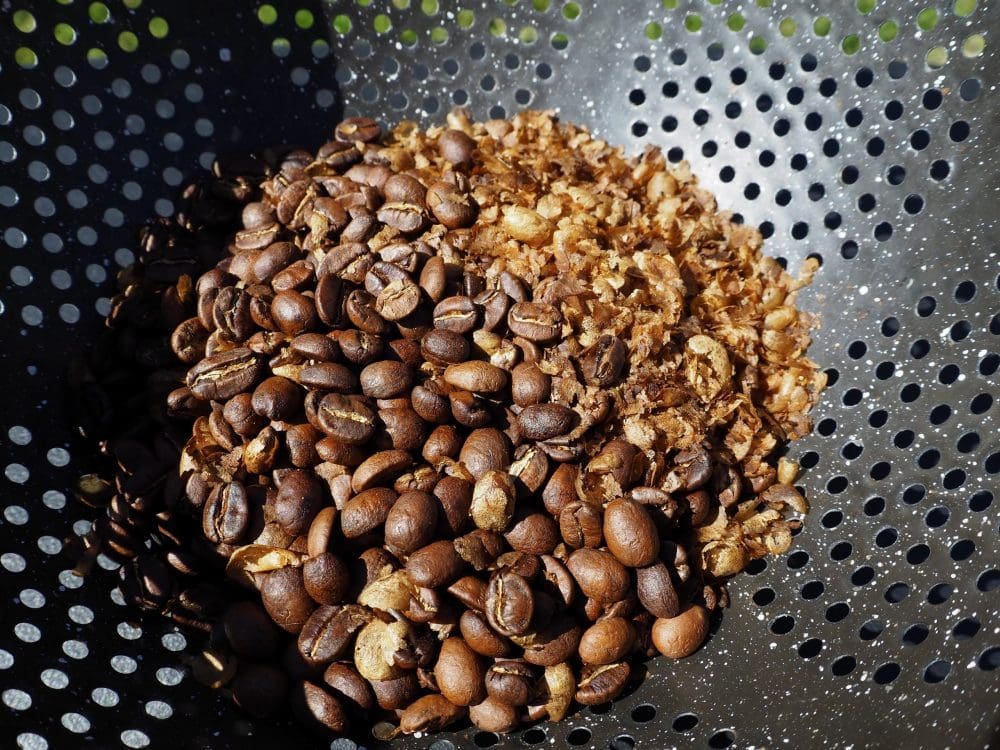
3. Chaff
There is a by-product of roasting coffee called chaff. This is the dry husk of the coffee bean and can be messy. If you want to avoid a mess, take your beans outside or over the sink to cool them in the colander or bowl. If you are having a hard time removing the chaff, just shake the beans in your colander a little harder. A lot of motion will cause most of it to come off by itself.
4. Storage
After the beans are cooled, store them in an airtight container away from heat and light. Stored this way, your beans will stay fresh for up to a month. Don’t wait too long, though – their peak freshness will be in the first week after roasting!

First Method: Pan Roasting
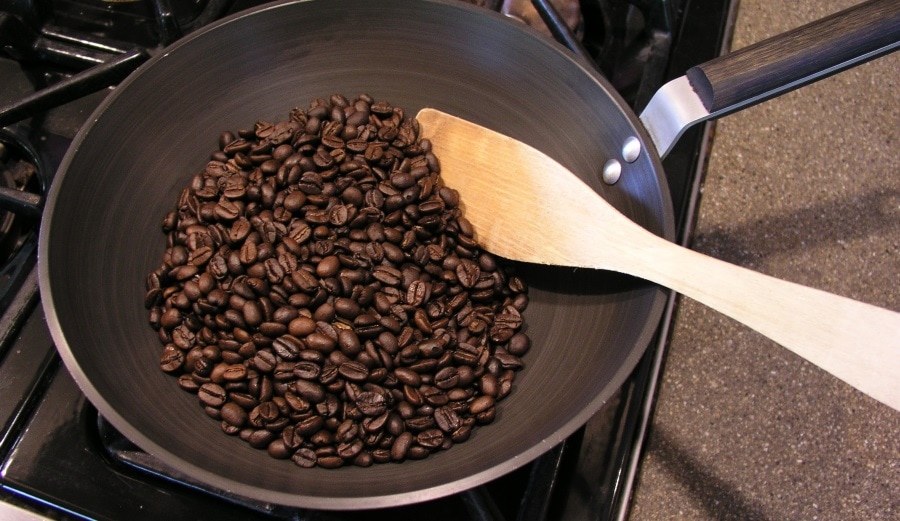
This method is comfortable because you are used to using a pan to cook meals. However, it can be challenging to do it just right. You might not have a consistent roast the first few times you go through the process. Don’t worry, though, we are here to guide you. The actual roasting will take 5 to 10 minutes, depending on how much you want your beans roasted.
Here are the items you need and the steps to roast coffee beans in a pan.
Things You’ll Need:
- 1/2 cup+ green coffee beans
- A pan (cast iron is best)
- Stove (electric or gas)
- Metal colander or bowl
- Oven mitts
- Wooden or metal spoon
Tip: Using a cast-iron pan will generate heat faster and hold it longer to help reach the right temperatures.
1. Heat your pan on medium to high heat.
Let the pan reach about 500 degrees Fahrenheit. Heat adjustment throughout roasting may be necessary, but don’t make it much hotter than 500 degrees.
2. Add your green coffee beans.
Measure out a half-cup of green coffee beans and pour them into the pan. You can adjust the amount if you want more, but start small. You want to be able to stir them around easily.
3. Stir regularly.
Start stirring and keep doing so while the beans roast. This helps the heat distribute evenly.
4. Watch for color changes and listen for cracks.
Let the beans change color from green to yellow to light brown and have their first crack. If you want a light roast, stop roasting. If you want medium roast, remove the beans from the heat after they change color to a golden brown, but before the second crack. If you want a dark roast, let them crack the second time, then remove them from the heat.
5. Transfer to a colander or bowl.
Once the pan of coffee beans is off the heat, dump them into the metal colander or bowl. Stir them around to keep them cooling down. Be careful, since the beans are still around 450 degrees.
6. Allow the beans to de-gas.
Leave the beans in a container with the lid off for eight to 24 hours. This allows carbon dioxide to escape. You may be tempted to brew your aromatic beans right away, but you’ll want to hold off for the best flavor. Your coffee will be at its most delicious about 24 hours after roasting.
7. Enjoy and store in an airtight container!
Grind your beans just before brewing and store the remainder in an opaque, airtight container.

Second Method: In the Oven
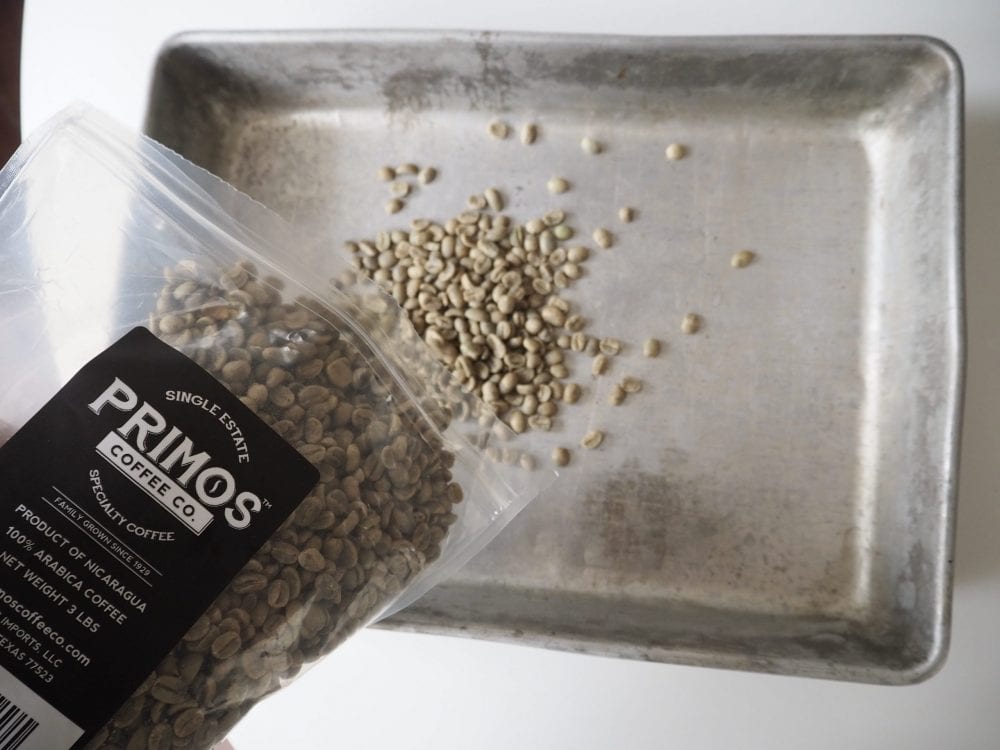
Oven-roasting your beans is another simple method, you’ll need to stir and check on them regularly. A plus side to this method is that it gets even roasting results in 5 to 10 minutes.
The steps are largely the same as the stove method. Heat your oven to 500 degrees Fahrenheit and spread half a cup of green coffee beans evenly on a baking tray. Stir every one to two minutes, observing color changes and listening carefully for the first and second cracks. Remove from the oven and follow steps five to seven above.

Third Method: Popcorn Popper
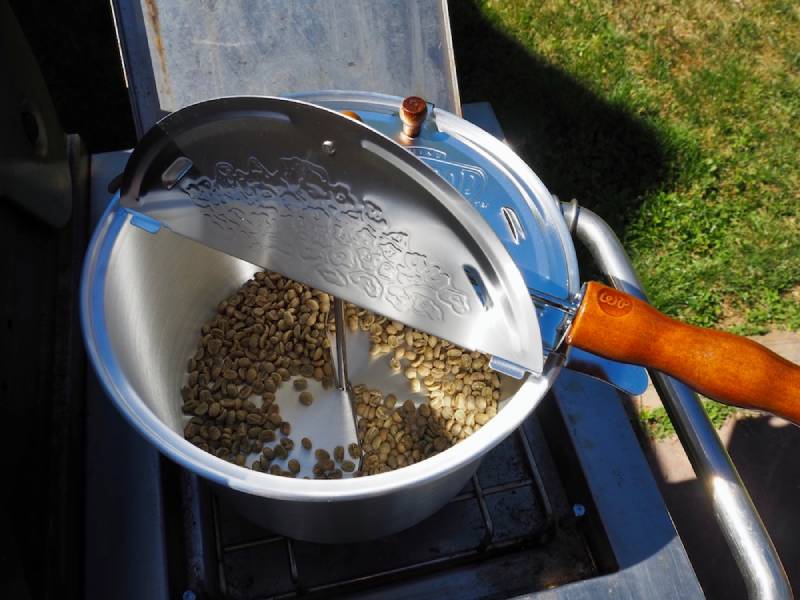
Our third method may be a little more unexpected: an old-fashioned popcorn popper. This method also takes five to 10 minutes. Make sure you buy the right kind of popper. Effective poppers have built-in stirring mechanisms that will make consistent roasting much easier.
We’ve written a detailed guide on roasting coffee in a popcorn popper, but here are the basics.
Pour half a cup of green coffee into your popcorn popper and place it over medium heat on a stovetop. Using the stirring mechanism, stir continuously, listening carefully for the first and second cracks. Remove from heat and follow steps five to seven above.

De-Gassing Your Beans

If you are roasting beans yourself at home, you have to know about de-gassing. Letting your beans de-gas is safer and will produce better flavors. If you’ve ever noticed the one-way vent on coffee bags, this is what it’s for: letting carbon dioxide escape while keeping oxygen out.
First, let us explain what de-gassing is. During the roasting process, gases form inside the coffee beans. After roasting completes, the gases, mostly carbon dioxide, start seeping out. Much of the carbon dioxide will leave the beans within the first 24 hours.
What’s the best way to de-gas? Just place your beans in the storage container you plan to use, but keep the lid off or slightly open for the gases to escape. De-gassing is necessary after roasting for at least a few hours and up to 24 hours as mentioned. After that point, you’ll want to seal the container, which keeps oxygen out and helps your beans stay fresh and flavorful.

Final Thoughts
Roasting coffee beans at home is truly a special skill that, according to those who do it, can quickly become an addiction. Freshly roasted beans are incredibly flavorful and aromatic, so many people can’t go back to store-bought beans after roasting their own.
Though it may seem tricky at first, roasting coffee isn’t overly complicated. We have shown you three different ways you can roast your own coffee at home, along with all the information you need to do it right. Try one of our methods out and see for yourself why so many coffee lovers have started roasting their coffee at home.
While it’s a fun activity, many asked us if it’s really worth the time and effort. Read our thoughts here.
SEE ALSO: Watch the coffee roasting process in a mesmerizing new video!
Featured Image Credit: Caitlin Custer, Shutterstock















